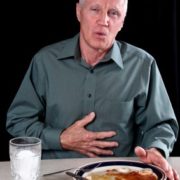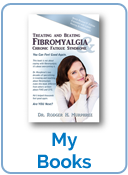Foods To Avoid with Elimination Diet when You have Fibromyalgia
Symptoms associated with fibromyalgia can be minimized by eliminating allergen rich foods.
 My specialty for almost two decades has been treating fibromyalgia. I have used several types of food allergy elimination diets over this time to help patients with fibromyalgia get relief. The purpose of a food elimination diet is to help my patients discover if they have any allergies or intolerances to foods that they do not know about it. Foods which we have an allergy (true antibody reaction as seen on a blood test) or intolerance to can trigger a host of unwanted symptoms. These symptoms or reactions can include headaches, fatigue, stomach discomfort (bloating, gas, reflux, loose bowel movements), achy muscle or joint pain, fuzzy thinking, low moods, anxiety, and more.
My specialty for almost two decades has been treating fibromyalgia. I have used several types of food allergy elimination diets over this time to help patients with fibromyalgia get relief. The purpose of a food elimination diet is to help my patients discover if they have any allergies or intolerances to foods that they do not know about it. Foods which we have an allergy (true antibody reaction as seen on a blood test) or intolerance to can trigger a host of unwanted symptoms. These symptoms or reactions can include headaches, fatigue, stomach discomfort (bloating, gas, reflux, loose bowel movements), achy muscle or joint pain, fuzzy thinking, low moods, anxiety, and more.
Sometimes these symptoms are mild and a person will not know they are intolerant, but everyone has food intolerances. It is very often to a food(s) they eat all the time. Figuring out what these foods are and eliminating them from the diet often helps patients to have decreased pain, less fatigue, milder GI symptoms, more stable moods, and a decreased chance of fibro fog.
Some patients will not experience a dramatic change in their symptoms, and some will not even experience a noticeable change. For many patients though, the elimination diet taken from my book Treating and Beating Fibromyalgia and Chronic Fatigue Syndrome, is definitely worth trying out.
Following an Elimination Diet
Phase One: Elimination
For a period of one month, follow these guidelines:
- Avoid all foods which may be an allergen. Start with the ones you know are possible problems, then add the ones you suspect.
- Completely eliminate soda; this includes Coke, Pepsi, Mountain Dew, Ginger Ale, Sprite, etc…
- Reduce the amount of caffeine consumed in other forms. Tea is high in caffeine, but drinking green tea or herbal tea is a good solution. Pay attention to the obvious sources of caffeine (coffee and energy drinks) and the not-so-obvious ones (chocolate and cocoa). The lower the amount of caffeine consumed in a day, the better. To avoid withdrawal symptoms, wean yourself off slowly. Start by eliminating 25% then continue to increase that until you are 100% off caffeine.
- Divide your caffeine sources as a serving. If you drink two cups of coffee per day, then three glasses of tea, and a chocolate bar for dessert, then you have had six servings of caffeine. This can help you eliminate caffeine, start by 25% of these servings. In the case above it would mean removing 1.5 servings per day to start. From here continue to remove servings every week until the caffeine is no longer part of your daily diet. For some patients, this will be a permanent step, for others, it will be a temporary change.
- Avoid dairy products of all types. Butter and eggs are allowed, but milk, yogurt, cheese, and ice cream need to be eliminated.
- Remove gluten-containing foods from your diet: Muffins, tortillas, pasta, pretzels, cake, pie, pastry, etc… Basically avoid any foods that contain wheat, oats, barley, rye, millet, sourdough, and spelt. Since gluten intolerance is more prevalent now, many gluten-free alternatives are available.
Phase Two: Reintroduction of Foods
 After spending at least 30 days on the elimination diet, slowly reintroduce one eliminated food group at a time, waiting 3-4 days before challenging each food group-it can take 3 days before you have a reaction from a challenged food.
After spending at least 30 days on the elimination diet, slowly reintroduce one eliminated food group at a time, waiting 3-4 days before challenging each food group-it can take 3 days before you have a reaction from a challenged food.
If you choose to reintroduce gluten first, start with several servings. Then do not eat anything in that group, or any of the eliminated groups, for at least 4 days. Be sure to keep a journal to track your body’s reaction to the food. Be sure to record symptoms, feelings, mood changes, bowel changes, and anything else that seems important.
After the three days is over try another group; for example, dairy. Try a glass of milk, some cheese slices, or a yogurt cup. Eat enough to get your body’s reaction, but not so much that it could be dangerous. If there are no bad reactions (headaches, bloating, pain, stomach aches, runny nose, congestion, fatigue, etc…) after three days, then the food group can begin to make its way back into your regular diet. Any foods that do give you negative reactions within the three days should be left out of your diet for another month. Then, try the three-day process again to see if the symptoms are still there.
Once you figure out which foods give you a bad reaction, you will know what foods to avoid in your day-to-day diet. Avoid the foods you have a reaction to for at least another month, evenr better 2, then re-challenge the offending food.
This diet, though designed for patients with fibromyalgia, can be done by anyone who wants to find out what foods they are allergic or intolerant too.
You can find out more about my Elimination Diet in my book Treating and Beating Fibromyalgia and Chronic Fatigue Syndrome. Discover more about my book at www.getfibrobooks.com
Foods To Avoid with Elimination Diet when You have Fibromyalgia











Thank you for this post.
When you direct in Phase One to eliminate soda, is it due to the carbonation? Or do you mean anything with corn syrup in it?
There is a bottled green tea which has corn syrup in it, but wouldn’t fit the criteria as I read your list, but it should likely be eliminated, as well.
Green tea is great. Sodas are not-loaded with sugar, additives or nutrasweet.
the best way to solve the problem with allergens in foods and fibromyalgia is doing the Naet treatment ,then you are able to eat anything with no side effects
go to naet.com
Finally! Someone that can maybe answer hard questions and various symptoms..I removed alot of foods I felt were helping my flareups and severe heartburn-reflux ignite. Seems to help so much by just not eating what I have experienced the culprit of this devastating disease.